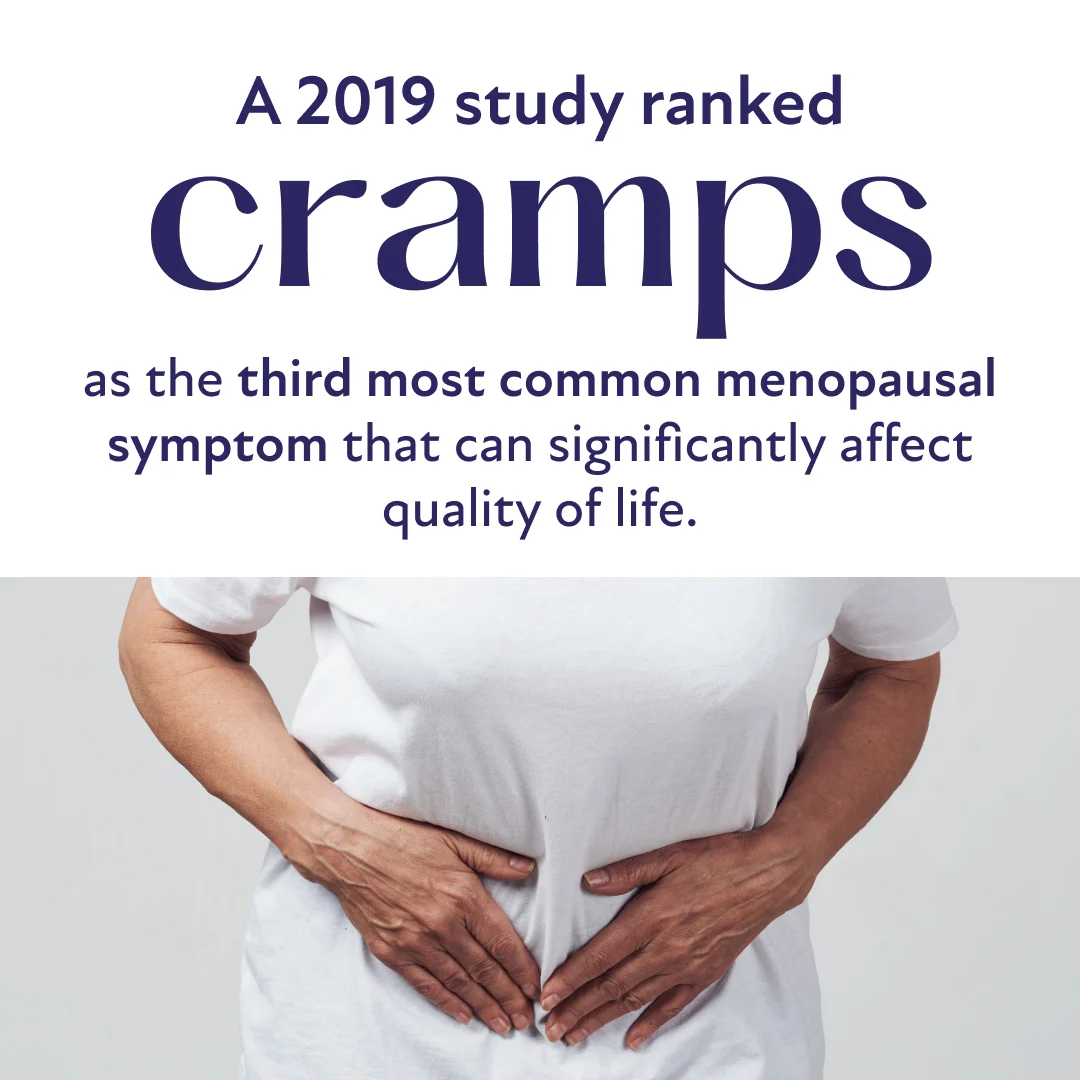Menopausal cramps can vary in type, but this article focuses specifically on stomach or abdominal cramps. Abdominal cramps are a common symptom across all ages and genders, accounting for nearly 11% of all emergency department visits.(1) While cramps are more common in women during the menstrual cycle, they can also occur during menopause. A 2019 study ranked cramps as the third most common menopausal symptom that can significantly affect quality of life.(1)
Menopausal abdominal cramps may resemble menstrual cramps, but their causes are different. Menstrual cramps often result from uterine contractions, whereas menopausal cramps could indicate underlying conditions like fibroids or endometriosis.
Consulting a physician is essential to uncover the underlying cause of menopausal cramps and determine the most effective treatment. This approach can greatly enhance the quality of life for individuals experiencing cramps during menopause.

Why do cramps occur during menopause?
Menopause can cause various changes in the body, which can contribute to cramping in the following ways:
Hormonal Imbalance
The balance between estrogen and progesterone is essential for maintaining the thickness of the endometrium (the lining of the uterus). Estrogen stimulates the growth of the uterine lining, while progesterone helps prevent overgrowth or hyperplasia.(2)
In some cases, progesterone levels may drop more significantly than estrogen during menopause. A relatively higher level of estrogen compared to progesterone can cause excessive thickening of the endometrium, leading to symptoms like heavy or irregular bleeding and painful cramps as the body attempts to shed the thicker lining.(2)
Excess estrogen can also cause an increase in prostaglandins, hormone-like compounds that trigger uterine contractions. While prostaglandins are necessary for normal uterine function, elevated levels can result in painful cramps.(3)(4)
Health Conditions Occurring During Menopause
Common conditions linked to menopausal cramps include the following:
Uterine Fibroids: These benign uterine growths are linked to higher estrogen levels. While some women may experience fibroids during the menopausal transition, they often shrink after menopause. Fibroids can cause symptoms like cramps and pelvic fullness.(5)
Endometriosis: This is a condition where cells similar to the endometrial cells grow outside the uterus, often on the ovaries, pelvic lining, and fallopian tubes. Some women may continue to experience endometriosis during menopause, with cramps being a common symptom.(6)
Gastrointestinal (GI) Issues: Estrogen plays a key role in regulating gastrointestinal function. As estrogen levels decline during menopause, conditions like irritable bowel syndrome (IBS) can worsen, often causing cramps.(7)
Symptoms of Cramps During Menopause
Abdominal cramps can be accompanied by symptoms of the underlying cause, such as the following:(5)(6)(7)
Light or heavy vaginal bleeding
Abdominal swelling or bloating
Swelling or pain in the legs
Lower back pain
Constipation
Nausea, vomiting, or diarrhea
Important Considerations When Experiencing Menopausal Cramps
Anyone experiencing severe, persistent cramps should consult a physician who can help in identifying the underlying cause. Early intervention can help address potential complications and improve overall health and quality of life.
Symptoms like abnormal vaginal bleeding may indicate a worsening of the condition and require prompt medical attention.
Effective Strategies to Manage Menopausal Cramps
Below are strategies that can help alleviate menopausal cramps:
Heat Therapy: Applying a heating pad or warm compress to the lower abdomen or back can help relax muscles and ease cramps. Research shows that heat can be as effective as painkillers like ibuprofen for relieving cramps.(8)
Pain Relievers: Over-the-counter pain relievers like ibuprofen or acetaminophen can help manage mild to moderate cramps.(9)
Lifestyle Modifications: Maintaining a healthy weight, managing stress, and getting enough sleep can help reduce the frequency and severity of cramps. Regular exercise can improve blood circulation and alleviate cramps.(9)
Dietary Changes: A lower intake of inflammatory foods, such as processed sugars and unhealthy fats, may help lessen the intensity and frequency of cramps. A balanced diet rich in fiber from vegetables, fruits, and whole grains can help lower prostaglandin levels. Limiting salt intake can prevent bloating, which often aggravates cramps. It also helps to avoid caffeinated drinks (coffee, tea, and soda) and alcohol, as they may worsen cramps.(9)
Additional Tips for Managing Menopause Cramps
In addition to lifestyle and dietary changes, there are other effective methods that can help alleviate cramps during menopause:
Relaxation Techniques: Mind-body practices such as deep breathing exercises, yoga, or meditation can help manage stress, promote relaxation, and reduce cramps during menopause. Regular practice of these relaxation techniques has been shown to improve sleep, mood, and overall health.(10)
Supplements: Some women may benefit from supplements like magnesium, zinc, vitamin D, or fish oil, as deficiencies in these nutrients can cause cramps. However, not everyone may need these supplements, so it’s important to discuss these options with a doctor before taking them.(11)
Hormone Replacement Therapy (HRT) for Menopause Cramps
HRT helps balance declining hormones during menopause, potentially alleviating cramps caused by hormonal imbalances. A physician can evaluate symptoms and determine whether HRT is the right option for individuals experiencing cramps during menopause.
This treatment option is available in various forms, primarily using synthetic or bioidentical hormones. Bioidentical hormones are derived from natural sources and have the same molecular structure as the body’s own hormones. This similarity allows bioidentical hormones to function more naturally and often results in fewer side effects compared to synthetic hormones.(12)
Experiencing cramps during menopause? Discover if HRT is right for you.
If you’ve entered the menopause transition and are struggling with cramps, don’t suffer in silence. Take our brief menopause quiz to see if you’re an eligible candidate for HRT. Get started with Winona to take the first step toward feeling better.
